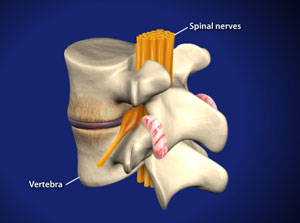What is spondylosis?
Spondylosis describes the “wear and tear” degenerative changes that occur as we age. This is essentially arthritis in your spine. Just like people get arthritis in their knees, hips, shoulders and other joints as we age, your spine develops arthritic and degenerative changes over time and certain parts need to be replaced. Spondylosis may also be thought of as all degenerative changes that affect the intervertebral discs, vertebral bodies, and/or associated joints of the lumbar spine. Spondylosis is common, but many people who have it may not experience any pain or need surgery.
Alphabet soup
Spondylolysis: pars defect or stress fracture
Spondylosis: spinal arthritis aka the ‘wear and tear’ of the spine
Spondylithesis: slippage of your vertebrae causing it to move forward or backwards
What causes spondylosis?
There are lots of different causes of spinal arthritis or spondylosis. The main cause is aging. Spondylosis is sometimes thought of as a cascade. One anatomical change occurs, which leads to more degeneration and changes in your spines structure. Other causes of spondylosis include:
- Spinal stenosis: an abnormal narrowing of the spinal canal (which has many causes) may contribute to pain. Read more about lumbar spinal stenosis here.
- Degenerative disc disease: dehydration of the disc due to age may cause the disc to release inflammatory proteins and cause it to lose some of its natural strength, causing micro-motion and pain. Read more about lumbar degenerative disc disease here.
- Facet joint arthritis: arthritis from your facet joints can cause more stress and pressure in your spine, which can lead to pain. Read more about facet joint syndrome here.

What are symptoms of spondylosis?
Symptoms of spondylosis can vary from patient to patient and depends on where and what part of the spine has the arthritis. This arthritis can be in the facet joints or vertebral bodies and cause back pain, or spinal canal and cause spurs which push on the nerves. Sometimes, it may not cause any symptoms at all. In general, it can cause:
- Pain and stiffness in the lower back that is worse in the morning and improves throughout the day
- Pain that may get better with changing positions Read more about lumbar disc degeneration disease here.
- Leg pain if bone spurs (excess bone from arthritis) compress your spinal nerves. Read more about lumbar radiculopathy here.
What are the treatments for spondylosis?
Because spondylosis is a descriptive term, the actual treatments are directed towards the underlying cause of the pain. For example, If the cause of your pain is from your facet joints, Dr. Webb will recommend treatment targeting your facet joint. If the source of your pain is from a disc herniation causing radiculopathy, then Dr. Webb will recommend treating that targets the disc herniation. Regardless of the cause of the pain, Dr. Webb goes through three phases of treatment. The overall goal of Dr. Webb’s conservative treatment levels are to improve strength and coordination of the muscles that surround the spine. Fortunately, most patients respond favorably to levels I and II and do not require surgery.
Level I – Conservative treatments
Level II Spinal Injections
- Facet joint injections: If your facet joints are the cause of your pain, then steroid injections into these joints is the next step. Steroids are used to calm down the swelling and allow pain relief. This is usually done with x-ray guidance.
- Epidural steroid injection: If your pain is in your legs and caused by compression of a spinal nerve, then Dr. Webb will recommend an epidural steroid injection. This is usually done with x-ray guidance.
Level III – Surgery
- Reserved for those who fail to improve with levels I and II of conservative treatment and is directed at the source of pain.
